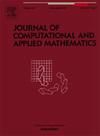求解第一类奇异积分方程的修正同伦摄动法
IF 2.1
2区 数学
Q1 MATHEMATICS, APPLIED
Journal of Computational and Applied Mathematics
Pub Date : 2025-05-21
DOI:10.1016/j.cam.2025.116753
引用次数: 0
摘要
同伦摄动方法(HPM)作为解决科学、工程和技术各个领域的线性和非线性问题的强大工具而脱颖而出。本文探讨了标准HPM法和修正同伦摄动法(MHPM)作为第一类柯西型奇异积分方程半解析解的应用。该方法有效地将奇异积分方程转化为代数积分方程的迭代序列。初始迭代引入了未知系数,而这些系数的明智选择通常会导致问题的精确解。通过算例验证了该方法的有效性和准确性。最后,将所得结果与HPM、Jacobi多项式近似和Taylor近似的结果进行了比较。最后,建立了该方法在适当的函数范围内的稳定性分析和收敛性。证明了在考虑特征si的情况下,对于任何初始猜测的选择,HPM和MHPM得到的解都与精确解一致。本文章由计算机程序翻译,如有差异,请以英文原文为准。
Modified homotopy perturbation method for solving singular integral equations of the first kind
The Homotopy Perturbation Method (HPM) stands out as a robust tool for addressing linear and nonlinear problems across diverse domains of science, engineering, and technology. This paper explores the application of both the standard HPM and modified Homotopy Perturbation Method (MHPM) as semi-analytical solutions for first-kind Cauchy-type singular integral equations (CSIEs). The proposed method effectively transforms singular integral equations into an iterative sequence of algebraic integral equations. The initial iteration introduces unknown coefficients, and a judicious selection of these coefficients often results in the precise solution to the problem. Several examples are presented to display the validity as well as accuracy of the MHPM. Lastly, the obtained results are compared with those derived from HPM, Jacobi polynomials approximation and Taylor approximation. The paper concludes by establishing the stability analysis as well as convergence of the proposed method within a suitable class of functions. It is proven that if characteristic SIEs is considered then the solution obtained by HPM as well as MHPM will coincides with exact solution for any choice of the initial guess.
求助全文
通过发布文献求助,成功后即可免费获取论文全文。
去求助
来源期刊
CiteScore
5.40
自引率
4.20%
发文量
437
审稿时长
3.0 months
期刊介绍:
The Journal of Computational and Applied Mathematics publishes original papers of high scientific value in all areas of computational and applied mathematics. The main interest of the Journal is in papers that describe and analyze new computational techniques for solving scientific or engineering problems. Also the improved analysis, including the effectiveness and applicability, of existing methods and algorithms is of importance. The computational efficiency (e.g. the convergence, stability, accuracy, ...) should be proved and illustrated by nontrivial numerical examples. Papers describing only variants of existing methods, without adding significant new computational properties are not of interest.
The audience consists of: applied mathematicians, numerical analysts, computational scientists and engineers.

 求助内容:
求助内容: 应助结果提醒方式:
应助结果提醒方式:


